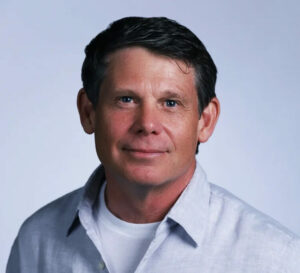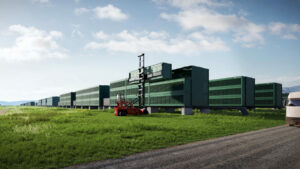CarbonCapture, which is developing machines that remove carbon dioxide from the atmosphere, suddenly is seeing some big potential.
For one thing, the recently passed Inflation Reduction Act incentivizes some companies to buy credits that offset their carbon dioxide production – which is what CarbonCapture sells. What’s more, the company this month signed an agreement with a firm that permanently stores the captured carbon underground.

As if to underscore its more promising future, CarbonCapture recently created a headquarters. Setting up the new shop was an important milestone, according to Chief Commercial Officer Jonas Lee.
“(The headquarters) is in the L.A. Arts District, where there’s good light-manufacturing buildings that are big and can fit office space, they can fit lab space and they can fit a big garage, (which is) essentially where we can build our machines,” Lee said. “So, it’s really hard to find that kind of combination of elements.”
Because it plans to expand its 40-person employee roster to a couple of hundred employees in the next year and a half or so, it was important that the company could grow into its approximately 24,000-square-foot facility.
He noted that having scientists, engineers and business employees so close to one another could potentially turn lead times for processes and corrections from days or weeks to minutes.
The company previously worked with Pasadena-based Idealab, a technology incubator that has helped grow more than 150 startups since its founding in 1996. CarbonCapture used its time with Idealab to develop prototype projects that worked toward developing the mechanics, energy use, capture efficiency and purity factors of its direct air-capture machine.
According to Lee, CarbonCapture appreciated its time at IdeaLab but arrived at a point where its growth was being impeded by not having its own place to call home.
“When you’re grown in an incubator like Idealab, you’re sort of in your parents’ basement basically, right?” Lee said. “You’re borrowing some space of theirs. They love to have you there, and they want you there as long as possible. But they want you to grow up, too, and this was a signal or milestone that we grew up and moved out of that basement.”
Scaling up
The machine produced by CarbonCapture has been scaled up to a commercial device since its days at Idealab. It now works by using solid sorbents to soak up atmospheric carbon dioxide, which is then released as concentrated carbon dioxide when heated. The concentrated carbon dioxide is then stored underground permanently or used to make products that require clean carbon dioxide for their manufacturing.
In a market that includes other direct air-capture companies, including Climeworks, Global Thermostat and Carbon Engineering, a key factor of CarbonCapture’s tech, according to Lee, is that it is not based on one carbon sponge, the part of the machine that absorbs carbon dioxide. With the platform that CarbonCapture has built, its machine can use different carbon sponges.

“There are hundreds of labs working on different carbon sponges around the world and there’s a game of leapfrog going on,” Lee said. “We want to make sure we can always take the best carbon sponge and put it into our system and adapt it to that sponge.”
The CarbonCapture machine is also modular, meaning it can be stacked in nested tiers with others. Nest enough machines in one area and they can all be connected to produce an entire array that removes large amounts of carbon dioxide from the atmosphere.
CarbonCapture plans to use the machines in that very way in the near future, as it announced this month an exclusive partnership with carbon storage developer Frontier Carbon Solutions that seeks to permanently remove 5 million tons of atmospheric carbon dioxide annually by 2030.
The partnership, dubbed “Project Bison,” will be based in Wyoming and be a way for CarbonCapture to profit from its technology.
Project Bison will generate carbon removal credits by capturing CO2 from the atmosphere and storing it underground.
Carbon removal credits generated by the CarbonCapture machines will then be sold to organizations with net-zero goals that need to offset their emissions. Lee gave air travel companies as an example of producers of carbon dioxide that can offset such emissions with the purchase of credits.
“For every ton that we (store), we create one carbon removal credit, and that credit has a value to companies with net zero goals,” Lee said.
The company’s credits now range between $600 and $700 for each ton of CO2, but it sees those prices coming down to less than $250 by 2030.
Operational soon
Wyoming was selected for the project because of the availability of renewable and zero-carbon energy sources. No machines have yet to be deployed by CarbonCapture, but the project is expected to be operational by late next year.
“With the passage of the Inflation Reduction Act, the proliferation of companies seeking high-quality carbon removal credits, and a disruptive low-cost technology, we now have the ingredients needed to scale (direct air capture) to megaton levels by the end of this decade,” Adrian Corless, CarbonCapture’s CEO and CTO, said in a statement.
CarbonCapture has so far funded its operation via fundraising, raking in $35 million in Series A funding last year. At that point, equity financing raised by CarbonCapture totaled more than $43 million.
A significant challenge for CarbonCapture is figuring out the best ways to use its technology as cheaply and sustainably as possible, according to Lee. “When you move a lot of air, it requires energy, so using renewables or zero-emissions energy sources is critical, because otherwise, you’re putting up carbon dioxide after capturing carbon dioxide, and that’s not good,” he said.
In terms of keeping things cheap, Lee said places like Wyoming are economically sound places into which to introduce his company’s technology because the cost of doing so is relatively low compared to setting up in urban environments, where space is more expensive and less available. For instance, setting up an array of machines in Los Angeles or San Francisco County would be difficult.
In line with Project Bison, CarbonCapture is now focused on scaling up as fast as it can following the completion of its headquarters.
